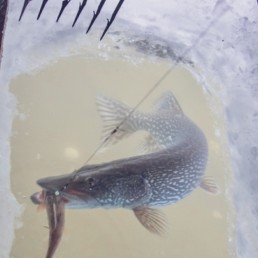Dark House Spear Fishing
SHARE THIS POST
Dark house anglers await their prey by waiting motionless in a low-light shelter, spear in hand.
Like the turkey hunter who sits hidden behind a camo-screened blind, or an archer silently perched in a treestand waiting for that prize buck to wander within range, dark house ice anglers seek their prey in the same manner: Waiting in a motionless, stealthy silence in a low-light shelter, spear in hand. Instead of depending upon their quarry returning down a worn game train, spear fishers rely on an appetizing, fish-shaped decoy they’ve hung a few feet below the surface to lure their quarry into striking distance within the visual confines of a rectangular hole in the ice.
Setting up a dark house spear fishing site is pretty straightforward: Choose a shallow-bodied area of a productive section of a frozen lake. Then cut a large, rectangular hole about 2 feet by 4 feet through the ice. To make it easier to see fish—and to prevent them from seeing up out through the hole to their looming death—a light-sealed “dark house” structure is placed over the hole. The spearers then suspend a life-size decoy down into the water to entice large fish (the targeted hungry or curious northern pike—a common, shallow-water hunter in its own right) to swim in to check it out.
The wait then begins for a legal-sized fish to swim under the window in range of the spear. The dark house angler, their pointed and barb-tined spear at the ready, waits for the perfect moment to plunge the spear deep into the hard, armor-like boney area behind the pike’s head and pull it up out through the ice.
When all goes according to plan, it’s marked up as another successful dark house spear fishing “hunt!”
Harvesting fish from up through river or lake ice has been part of indigenous cultures’ sustainable techniques for thousands of years, probably starting in several places concurrently across North America/Europe/Asia after the last ice age forward. Spearing predates the use of nets, traps and hook/lines by several millennia. The techniques developed by those cultures are still the primary methods used today.
The modern form of spear fishing dates to the early 19th century. Minnesota issued upwards of 50,000 spear fishing licenses in the 1950-60s; today, less than half that number are sold.
Local outdoorsman Rich Massey has been spearing fish in western Minnesota prairie lakes and rivers since he was ten years old. “It’s part of the area’s heritage”, he says. Massey also recounts times back in his youth when he and fellow spearers would work the local iced-over rivers. “We’d go down to the river and cut a very lengthy hole in the ice; we’d saw a long hole most of the way across the river. We’d then have a couple of the boys standing over that trench with spears while the rest of us went downstream a bit and pounded on the ice with baseball bats, driving the fish back up past the trench where they could be speared.”
Are you enjoying this post?
You can be among the first to get the latest info on where to go, what to use and how to use it!
Massey says that part of the attraction and success of dark house spearing is that it, “takes effort and several people to really make dark housing work.”
Minnesota DNR Area Fisheries Manager Chris Domeier says, “It’s the thrill of being ‘involved’ with the fish; that’s what’s unique. It is always fun to watch what’s going on in the lake, plus the occasional muskrat might pop out of the hole, which always creates some adrenaline.” Massey expressed the same sensation: “Looking down through this big window cut in the ice, it’s like having your own personal aquarium!”
Aside from the patient and sometimes prolonged anticipation of a successful spearing outing, there’s another alluring aspect to the sport: The traditional folk-art form of creating the fish decoys themselves.
Initially made of bone or antler, today most decoys are carved from wood and intricately painted. This artwork is often showcased at shows and conventions. Proportioned to be life-like to mimic the size and allure needed to attract monstrous, gapped-jawed northerns, the decoy also helps the spearer determine the size of the fish by comparing the attracted fish’s length with the known dimension of the decoy. “Decoys have been made out of baseball bats and 2 x 4 lumber, and can be up to 24” in length,” says Massey.
The heritage of dark house spear fishing continues to be alive and well throughout the frozen winter waters of the Northland.
Looking for some new fishing techniques to try this season? You’ll find plenty of suggestions in every issue of MidWest Outdoors. Subscribe on our website.
MWO
SHARE THIS POST
You may also like...
Nothing found.
Did you enjoy this post?
You can be among the first to get the latest info on where to go, what to use and how to use it!
Tom Watson
Tom Watson is a former team member of Kodiak Island Search & Rescue, kayak tour operator, and author of “How to Think Like a Survivor: A Guide for Wilderness Emergencies;” “Best Tent Camping—Minnesota;” “60 Hikes Within 60 Miles Minneapolis and St. Paul” and “Best Minnesota Camper Cabins.” (All available on Amazon.) He’s a freelance writer and presenter on self-reliance and other outdoor topics. tomoutdoors.com.
